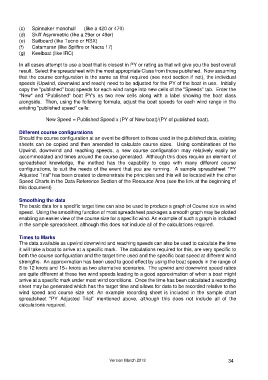Page 36 - Race
P. 36
(c) Spinnaker monohull (like a 420 or 470)
(d) Skiff Asymmetric (like a 29er or 49er)
(e) Sailboard (like Tecno or RSX)
(f) Catamaran (like Spitfire or Nacra 17)
(g) Keelboat (like IRC)
In all cases attempt to use a boat that is closest in PY or rating as that will give you the best overall
result. Select the spreadsheet with the most appropriate Class from those published. Now assuming
that the course configuration is the same as that required (see next section if not), the individual
speeds (Upwind, downwind and reach) need to be adjusted for the PY of the boat in use. Initially
copy the "published" boat speeds for each wind range into new cells of the "Speeds" tab. Enter the
"New" and "Published" boat PY's as two new cells along with a label showing the boat class
alongside. Then, using the following formula, adjust the boat speeds for each wind range in the
existing "published speed" cells:
New Speed = Published Speed x (PY of New boat)/(PY of published boat).
Different course configurations
Should the course configuration at an event be different to those used in the published data, existing
sheets can be copied and then amended to calculate course sizes. Using combinations of the
Upwind, downwind and reaching speeds, a new course configuration may relatively easily be
accommodated and times around the course generated. Although this does require an element of
spreadsheet knowledge, the method has the capability to cope with many different course
configurations, to suit the needs of the event that you are running. A sample spreadsheet "PY
Adjusted Trial" has been created to demonstrate the principles and this will be located with the other
Speed Charts in the Data Reference Section of the Resource Area (see the link at the beginning of
this document)
Smoothing the data
The basic data for a specific target time can also be used to produce a graph of Course size vs wind
speed. Using the smoothing function of most spreadsheet packages a smooth graph may be plotted
enabling an easier view of the course size for a specific wind. An example of such a graph is included
in the sample spreadsheet, although this does not include all of the calculations required.
Times to Marks
The data available as upwind downwind and reaching speeds can also be used to calculate the time
it will take a boat to arrive at a specific mark. The calculations required for this, are very specific to
both the course configuration and the target time used and the specific boat speed at different wind
strengths. An approximation has been used to good effect by using the boat speeds in the range of
8 to 12 knots and 15+ knots as two alternative scenarios. The upwind and downwind speed ratios
are quite different at these two wind speeds leading to a good approximation of when a boat might
arrive at a specific mark under most wind conditions. Once the time has been calculated a recording
sheet may be generated which has the target time and allows for data to be recorded relative to the
wind speed and course size set. An example recording sheet is included in the sample chart
spreadsheet "PY Adjusted Trial" mentioned above, although this does not include all of the
calculations required.
Version March 2018 34

